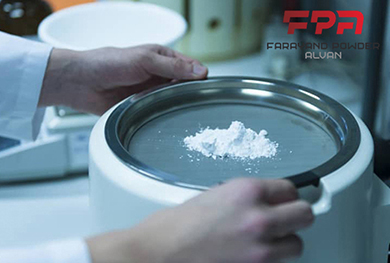General methods of test for pigments and extenders
Part 7:
Determination of residue on sieve — Water method
— Manual procedure
1-Scope
This part of ISO 787 specifies a general method of test for determining the residue on sieve from a sample of pigment or extender dispersed in water.
ISO 787-18, General methods of test for pigments and extenders — Part 18: Determination of residue on sieve — Mechanical flushing procedure, specifies a general method of test for determining the residue on sieve from a sample of pigment or extender by a mechanical flushing procedure.
For most pigments and extenders, ISO 787-7 and ISO 787-18 will usually give different results, and it is
therefore essential to state clearly in a specification which method is to be used and, in the test report, which method has been used.
Note: The general methods given in the various parts of ISO 787 are usually applicable to any pigment or extender.
Thus only a cross-reference to the appropriate part of ISO 787 needs to be included in the International Standard giving the specification for that pigment or extender, indicating any detailed modifications that may be needed in view of the special properties of the material in question. Only when the general methods are not applicable to a particular material should a different method for determination of residue on sieve be specified.
2-Normative references
The following referenced documents are indispensable for the application of this document. For dated references, only the edition cited applies. For undated references, the latest edition of the referenced document (including any amendments) applies.
ISO 565, Test sieves — Metal wire cloth, perforated metal plate and electroformed sheet — Nominal sizes of openings
ISO 3262-9:1997, Extenders for paints — Specifications and methods of test — Part 9: Calcined clay
ISO 4793, Laboratory sintered (fritted) filters — Porosity grading, classification and designation ISO 15528, Paints, varnishes and raw materials for paints and varnishes — Sampling
3-Sampling
Take a representative sample of the material to be tested, as described in ISO 15528.
4-Apparatus
Use ordinary laboratory apparatus and glassware, together with the following:
4.1-Sieve, of nominal mesh aperture as required, complying with the requirements of ISO 565. The nominal mesh aperture and the diameter of the sieve used shall be stated in the test report.
Sieves of nominal mesh aperture 45 µm are frequently used. It is recommended that the mesh apertures of the sieve be periodically examined, using a microscope, to establish that blockage or undue wear has not occurred. The sieve should be discarded if the mesh apertures have been affected.
4.2 -Brush, hog bristle, approximate dimensions 5 mm thick, 20 mm wide and 35 mm long.
4.3 -Sintered-glass crucible, of porosity grade P 40 (pore size index 16 µm to 40 µm) as defined in
ISO 4793, or 50 ml beaker.
4.4- Oven, capable of being maintained at (105 ± 2) °C.
4.5- Balance, capable of weighing up to 1 000 g to the nearest 0,1 g.
4.6- Balance, capable of weighing to the nearest 1 mg.
4.7- Desiccator, containing an efficient desiccant.
4.8- Washbottle, to contain the solution used to disperse the test portion.
5- Procedure
5.1- General
Carry out the determination in duplicate.
5.2- Test portion
Using balance 4.5, weigh, to the nearest 0,1 g, into a beaker of suitable capacity, a quantity of the sample such that a sufficient residue on the sieve (4.1) is obtained. Generally, a test portion of 10 g to 100 g is necessary but, in the case of products yielding a very low residue on the sieve, a larger test portion, up to 1 000 g, should be used.
5.3- Preparation of the dispersion
Disperse the test portion (see 5.2) in a suitable volume of water (about 300 ml to 600 ml) containing, if required, a suitable dispersing agent (see, however, the second and third paragraphs below). If the product specification advises that mechanical assistance is commonly required to achieve thorough dispersion, a stirrer and stirrer head as specified in ISO 3262-9:1997, Subclause 6.3.4 (see Annex A), shall be used, and it is recommended that the rotation of the stirrer should not exceed (500 ± 50) min-1. The use of a mechanical stirrer shall be stated in the test report.
If agreed between the interested parties, the test portion may be transferred directly to the sieve, without previous dispersion.
The quantity of the dispersing agent should preferably be between 0,2 % and 0,5 % of the mass of the test portion. The type and quantity of the dispersing agent to be used shall be agreed between the interested parties and indicated in the test report.
It is important that the dispersion of the pigment or extender in the aqueous medium be thorough and that no flocculation should occur during the determination (see 5.4).
5.4- Determination
Pour the dispersion, if necessary in portions, through the sieve (4.1). With the aid of a washbottle (4.8) filled with the solution used to disperse the test portion, rinse out the beaker and pour all the rinsings through the sieve. Wash the test portion with the same solution until the washings passing through the sieve are clear and free of dispersed material. When the test portion has simply been dispersed in water, tap water from a sprinkling rose may be used for rinsing.
Depending on previous agreement between the interested parties, either break up pigment agglomerates on the sieve by application of gentle pressure using a brush (4.2) or leave such agglomerates untreated. If a brush is used, wash any particles adhering to the brush onto the sieve and wash the residue on the sieve with water to free it from dispersing agent.
In order to avoid false test results, the water should preferably be filtered.
Treat the residue on the sieve in accordance with one of the following alternative procedures:
- a) Wash the residue with distilled water into a previously heated and weighed sintered-glass crucible (4.3),
allow the water to filter through and dry the residue in the oven (4.4) at (105 ± 2) °C for 1 h. Allow to cool
in the desiccator (4.7) and weigh to the nearest 1 mg. Use balance 4.6 for these weighings. Calculate the
mass of the residue.
- b) Transfer the residue with distilled water into a previously heated and weighed 50 ml beaker. Evaporate
the water and dry in the oven at (105 ± 2) °C for 1 h. Continue as described under a) above.
If the melting point of the residue on the sieve is lower than 110 °C, a more suitable drying temperature shall
be used and this shall be stated in the test report.
If the two determinations differ by more than 10 % of the larger value (unless the difference is less than 5 mg),
repeat the procedure (i.e. 5.1 to 5.4).
5.5- Examination of the residue
Inspect the residue for the presence of incompletely dispersed pigment or extender and, if present, repeat the whole process (i.e. 5.1 to 5.5) using an alternative dispersing agent agreed between the parties.
The nature of any extraneous matter in the residue shall be reported.
6- Expression of results
6.1- Calculation
Calculate the residue on sieve R, expressed as a percentage by mass, using the following equation:
R=100xm1/m0
where
m0 is the mass, in grams, of the test portion; m1 is the mass, in grams, of the residue.
Calculate the mean of two valid determinations and report the result to two significant figures. If the mean value is below 0,01 %, report the result as “less than 0,01 %”.
........................................................................................................
With over 30 years of experience in producing various industrial micronized powders and an experienced team with extensive knowledge of pigments, Farayand Powder Co. has been a reputable supplier in various industries and is honored to provide technical consultation to customers for the best and most economical solutions.


